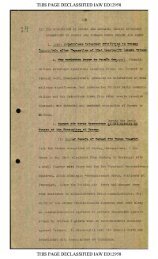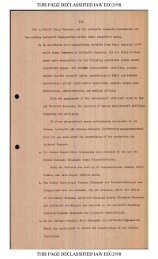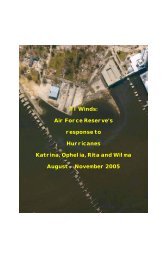Air Force Combat Units of WWII
Air Force Combat Units of WWII
Air Force Combat Units of WWII
You also want an ePaper? Increase the reach of your titles
YUMPU automatically turns print PDFs into web optimized ePapers that Google loves.
490 AIR FORCE COMBAT UNITS OF WORLD WAR I1April 1951, but the thrust was checked justshort <strong>of</strong> Seoul. After a lull, in which theUN strengthened its positions along thenew line, the Communists struck again,pushing back the eastern end <strong>of</strong> the line.Having again been driven south <strong>of</strong> the38th parallel, the UN counterattacked andby 24 June not only had regained the territorylost during the enemy’s spring <strong>of</strong>fensivebut had shoved the line deeper intoNorth Korea. It was then that Malik suggestedan armistice.UN Summer-Fall Ofiensive: 9 July to27 November 1951. Truce negotiationsbegan on 10 July, but hostilities continued,although neither side was willing to begina major <strong>of</strong>fensive while the peace talkswere being conducted. When negotiationswere suspended in August, the UNbegan an <strong>of</strong>fensive in the area known asthe Punchbowl, and in the fierce fightingthat followed was able to take some importantpositions, including Bloody andHeartbreak Ridges. After peace negotiationswere resumed in October, Ridgwaystopped <strong>of</strong>fensive operations on theground. In August FEAF had begun astrong campaign against the enemy’s railroads.For three months the results <strong>of</strong>the latter campaign were good, but afterwardthe Communists provided strongerdefenses and rushed repairs, thereby reducingthe effectiveness <strong>of</strong> the interdictoryoperations.Second Korean Winter: 28 November1951 to 30 April 1952. Terminating its<strong>of</strong>fensive, the UN waged a war <strong>of</strong> contain-ment, but the aerial attacks on railroads inNorth Korea continued. The ,UN’s interdictoryoperations, which destroyed somematerial and curtailed efforts to stockpilesupplies, so damaged the Communists’railway system that it could not be usedagain to support a sustained <strong>of</strong>fensive onthe ground. But interdiction could notforce the Communists to end the war.The enemy made some probing attacks,but there were no important changes inthe battle line.Korea Summer-Fall, 1952: I May to 30November 1952. In May 1952 the Communistsincreased their probing andstepped up their artillery fire. As a result,in June the UN began a limited action toadvance the patrol bases in front <strong>of</strong> theline, but the fighting was relatively <strong>of</strong>minor significance. Both sides madesome small-scale attacks during the summer.After knocking out most <strong>of</strong> theelectric plants in North Korea duringJune, FEAF began to apply continuouspressure on the Communists with the view<strong>of</strong> making the war as costly as possible interms <strong>of</strong> enemy personnel, materiel, andfacilities. The tempo <strong>of</strong> the action on theground increased in October, but therewere only minor changes in the line.Third Korean Winter: I December 1952to 30 April 1953. Activity along the frontsubsided during the winter, increasedsomewhat in March, but declined again inApril. Negotiations for an armistice wereapproaching a decisive stage, but it was








